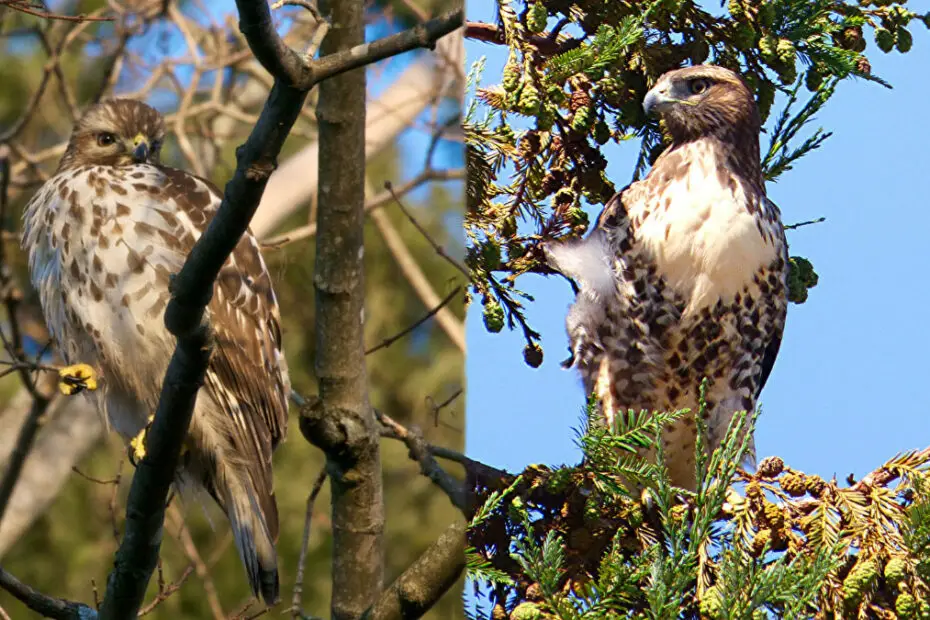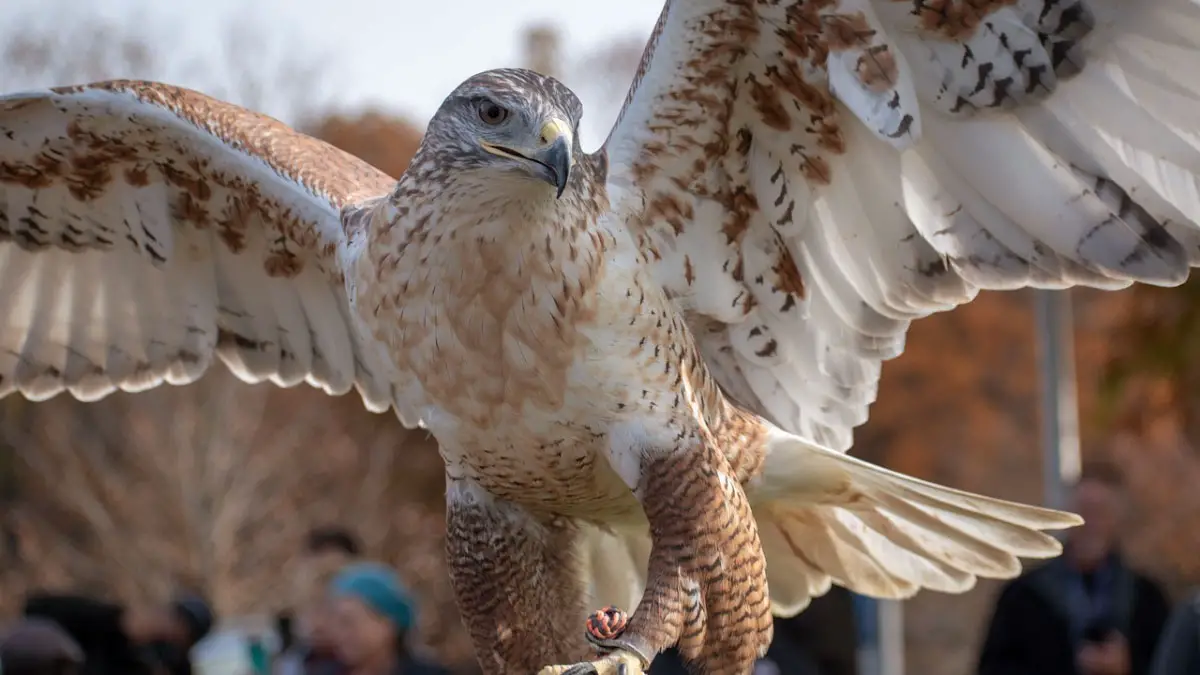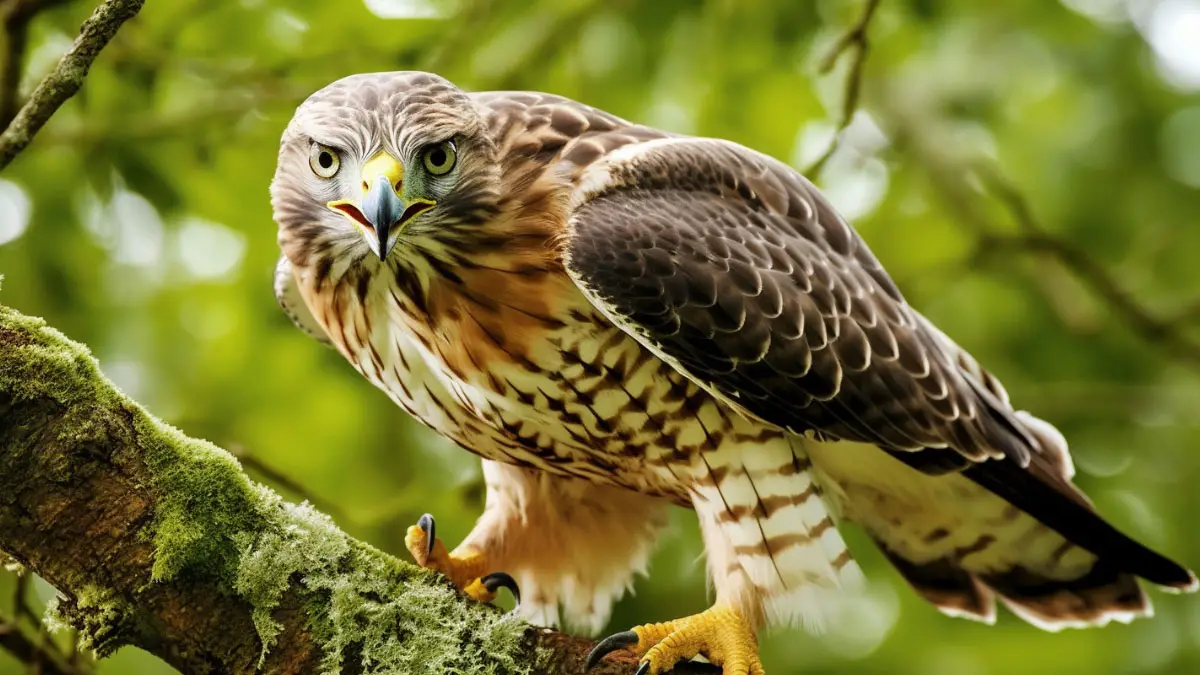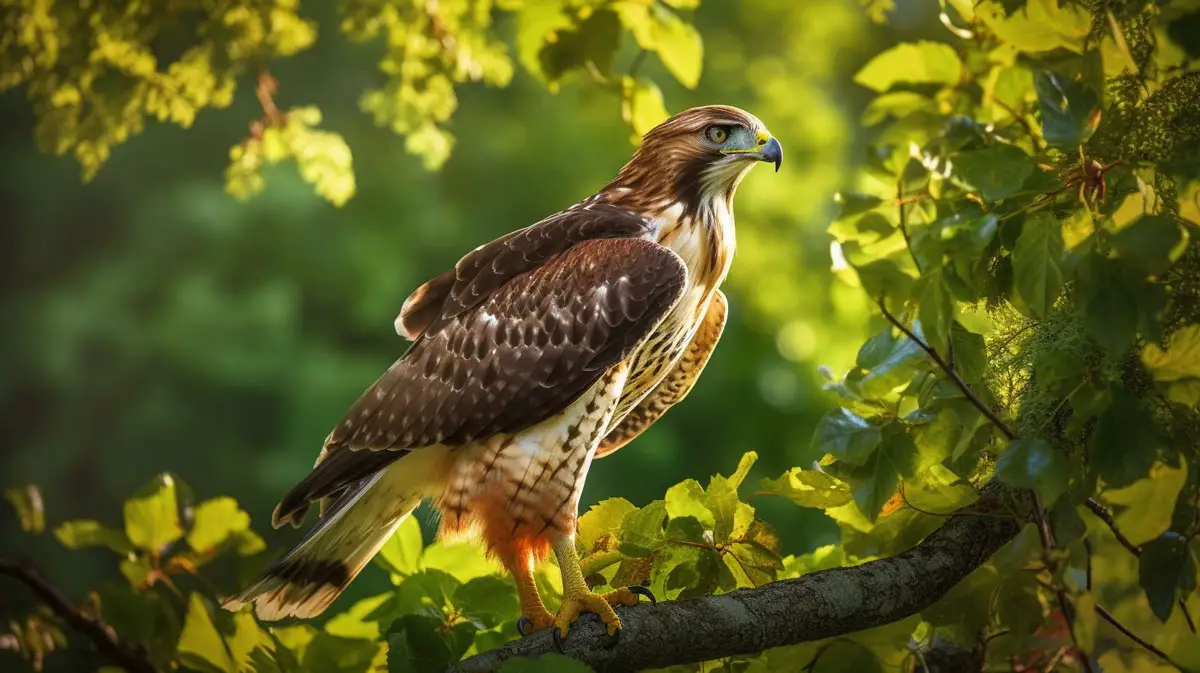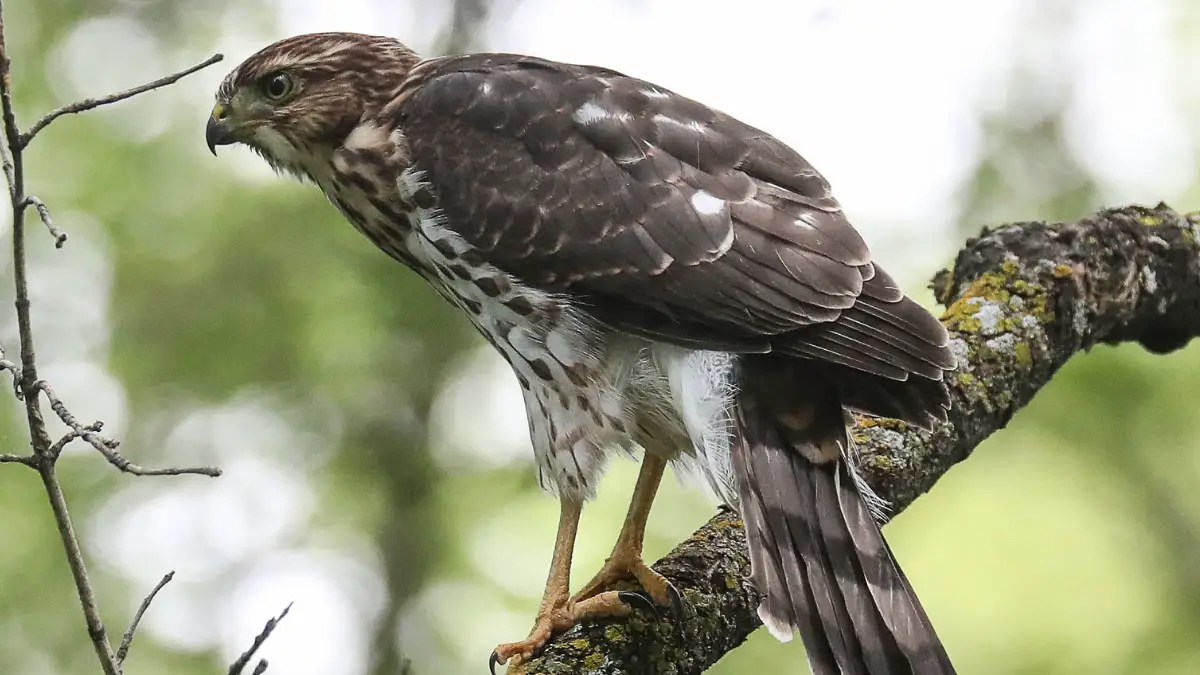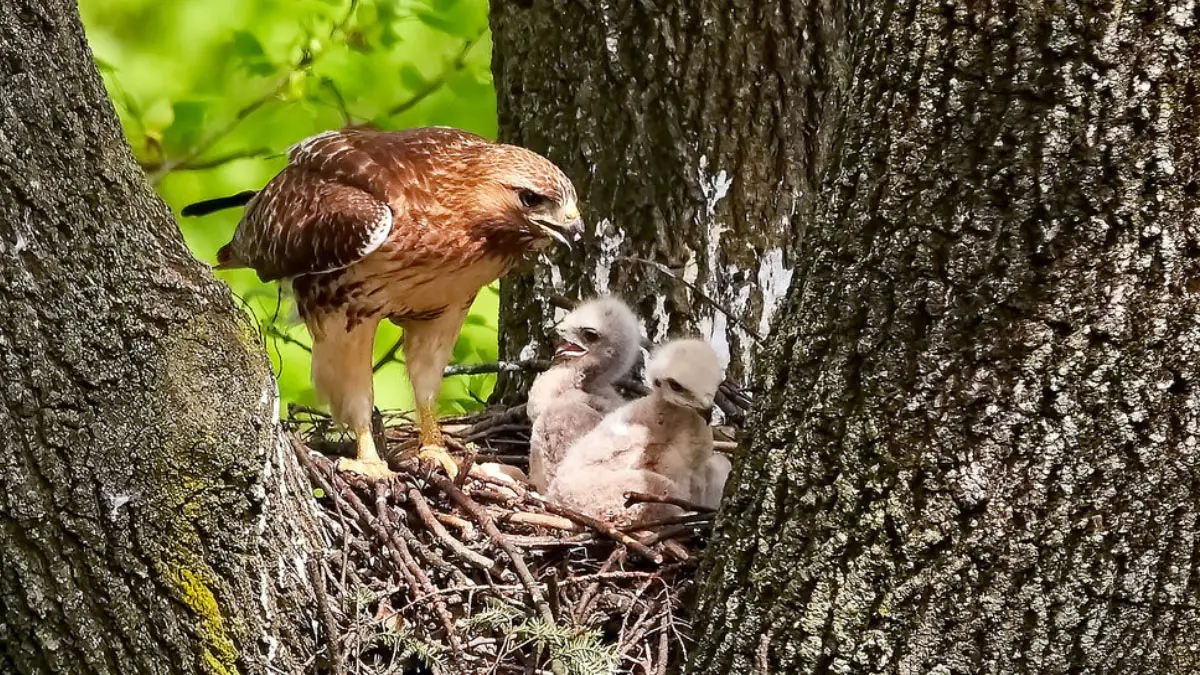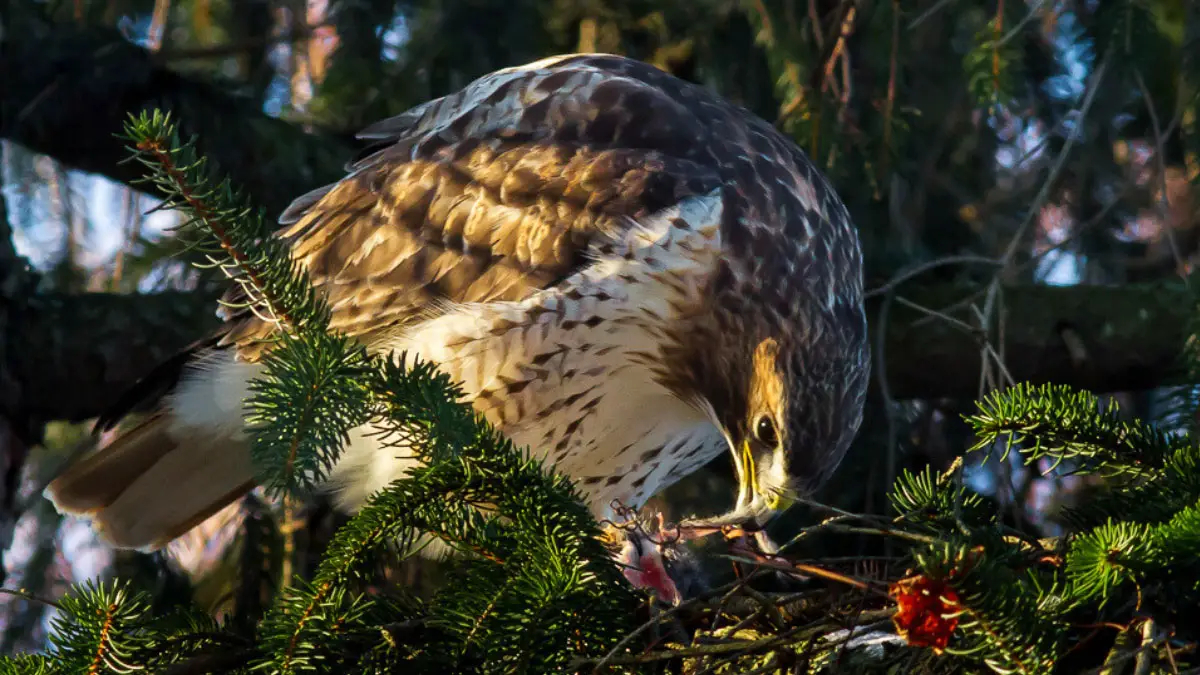The hawk and falcon are two of the most iconic and awe-inspiring species. With their sharp talons and powerful beaks, these birds have earned a reputation as formidable hunters of the sky. They share many similarities in their physical characteristics and hunting behaviors, but they also have some key differences.
So, what are the main differences while talking about Hawks vs Falcons? One of the most noticeable differences is their size and appearance. Falcons are generally smaller and more slender than hawks, with long, pointed wings and streamlined body that allows them to fly at incredible speeds.
However, it’s difficult to distinguish them by only a few physical factors. Their behavioral differences, habitat preferences, etc., play a significant role in differentiating one another.
Physical Characteristics
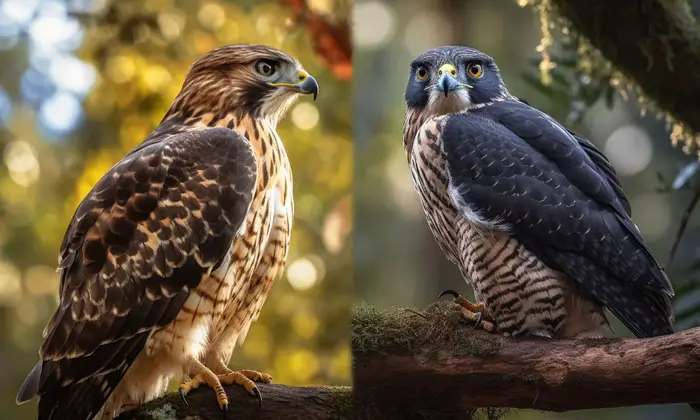
While these two birds of prey look similar at first glance, some distinct differences in their physical characteristics exist. Let’s take a look at the physical differences between Hawks and Falcons:
| Traits | Hawks | Falcons |
|---|---|---|
| Average Size | 45-65 cm | 15-60 cm |
| Weight | 1.5 to 3.5 lb | 0.7 to 2.20 lb |
| Color | Brownish above with a rust-colored tail | Blue-gray |
| Head Shape | Pointy heads | Roundheads |
| Wings | 17-44 inches | 29-47 inches |
| Talon Length | Up to 1.33 inches | 1.06 inches |
| Talon Shape | Markedly curved and tapered | Compact pear shape |
| Beak Shape | Curved | Hooked beak |
| Eyesight Range | 1 mile (1.6 km) | More than one-mile |
Comparison of Hawk and Falcon Size, Weight, and Wingspan
Size
Falcons are generally smaller than hawks, with an average length of 15 to 60 cm. On the other hand, hawks are much larger, with an average length of 45 to 60 cm.
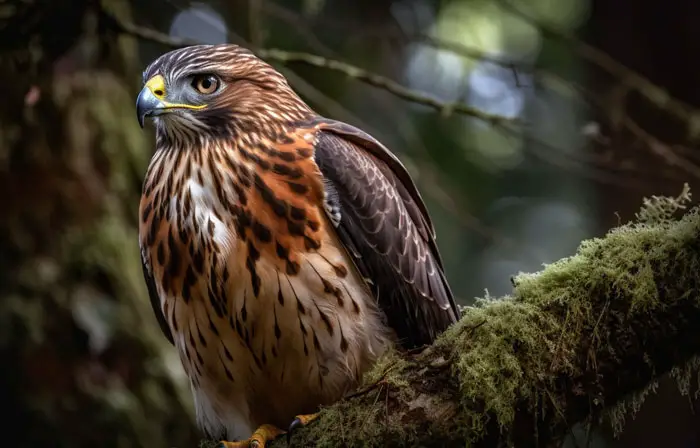
However, some hawks species, like Cooper’s Hawk, are smaller (23-37 cm) than an average size falcon.
Weight
The biggest hawks can weigh up to 3.5 pounds, while the heaviest falcon, the Gyrfalcon, weighs up to 3 pounds. However, most falcons weigh less than a pound, with an average weight of 0.7 to 2.20 lb.
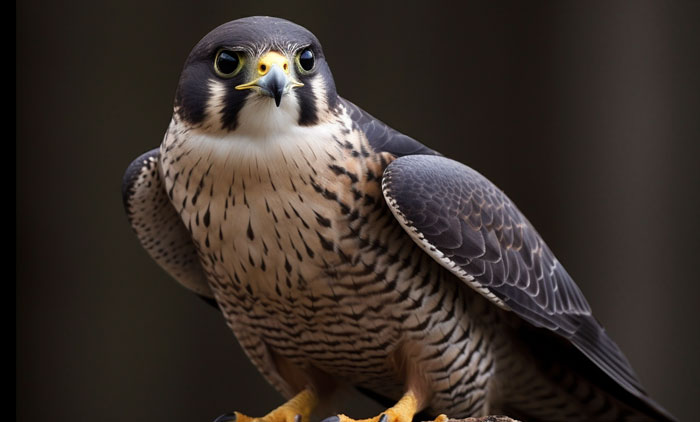
Wingspan
Falcons have longer wingspans, with an average wingspan of 29-47 inches, while hawks have shorter wingspans, with an average wingspan of 17-44 inches.
Differences in Feather Coloration, Patterns, and Markings
Depending on the species, hawks can have brown, gray, or even reddish-brown feathers. They have a pattern of dark bands or bars on their tails and wings, varying in intensity and number depending on the species.
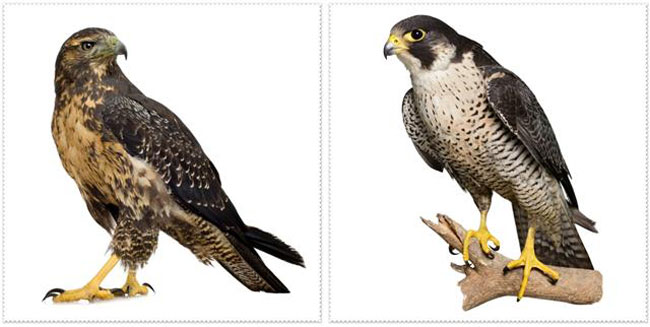
Falcons, on the other hand, tend to have more distinct and consistent blue-gray coloration. They tend to have more uniform feather patterns, with fewer or no bars on their tails and wings.
Hawks lack “belly bands” or “patagial bars” on the underside of their wings. In contrast, falcons may have distinctive “teardrop” or “sideburn” markings on the sides of their faces.
Comparison of Talon Length and Shape
The shape of the talons also differs. While hawk talons are curved and tapered, the talons of falcons are a pear shape and slightly shorter than hawks.
Differences in Beak Shape and Size
Falcon has a tomial tooth with a triangular notch, while hawks have a simple curve-shaped beak. A falcon’s beak can range from 1.5 to 3.5 cm, while a hawk’s beak can range from 2.5 to 7.6 cm.
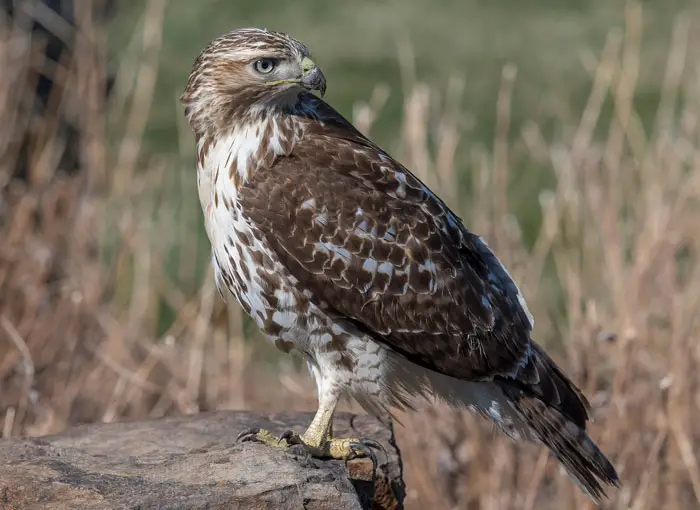
Adaptations that Allow Hawks and Falcons to Survive in Their Respective Habitats
Here are some adaptations that allow hawks and falcons to thrive in their respective habitats:
Sharp Beaks and Talons
Both have sharp, hooked beaks and powerful talons, which are specialized for catching and killing their prey. Their beaks are designed to tear through flesh, and their talons are strong enough to grip their prey animals tightly.
Excellent Vision
These birds have exceptional vision, allowing them to spot potential prey from great distances.
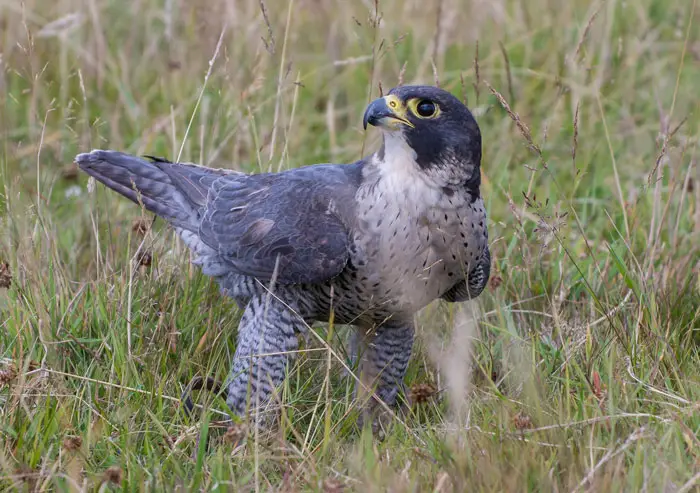
Powerful Digestive System
Both raptors have a highly efficient digestive system that allows them to process and extract nutrients from their prey quickly.
Excellent Camouflage
They’ve plumage that allows them to blend in with their surroundings, providing excellent camouflage while hunting.
Behavioral Differences
Though they belong to the same class in scientific classifications, these two birds have distinct behavioral differences that set them apart. Here are some key behavioral differences:
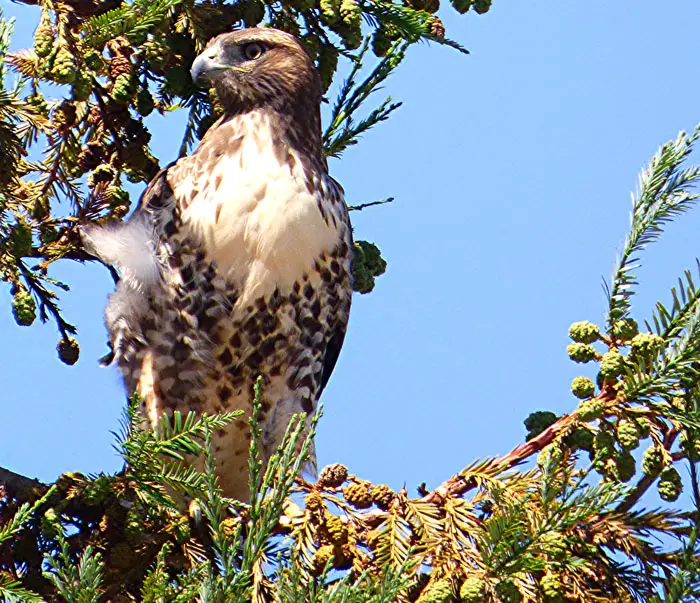
Comparison of Hunting Styles
Hunting behaviors of raptors may vary depending on the raptor species, habitat, and ecological bay. Although both of them use their talons to catch their prey, their methods of killing are distinct.
Hawks rely on their robust feet and sharp talons to tear their prey apart, while falcons have a unique serration or “tooth” on the side of their beaks that they use to deliver the fatal blow.
Differences in Hunting Efficiency and Prey Preferences
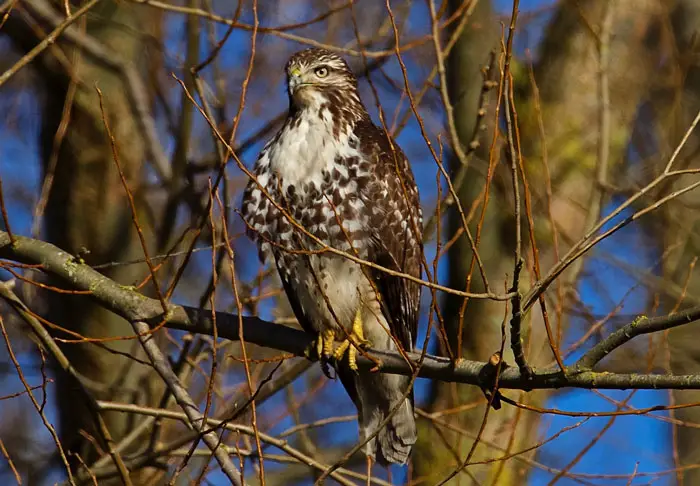
Prey Preferences
Falcon’s diet mainly consists of small birds like pigeons, songbirds, and budgerigars, comprising around 88% of their food, but they also eat small reptiles and mammals.
On the other hand, Hawks’ prey preference includes rabbits, squirrels, and other birds of similar or smaller size. Some larger species of hawks, like the Red-tailed, may even go after larger mammals, snakes, and rabbits.
Hunting Efficiency
Hawks have a success rate of around 10%. This may not seem like a high success rate compared to the Falcons.
They’ve got a success rate of around 12.6%. This is an incredibly high hunting efficiency due to the falcon’s incredible speed and agility.
Comparison of Migratory Patterns
During the season changes, raptor migration can be observed in search of more suitable climates.
They’ve different migratory patterns. Hawk migration typically occurs from August to mid-December and April to May. Their migration is commonly observed during the time frame of 8 am to 5 pm.
Falcons are renowned for their impressive long-distance migrations during the spring and fall seasons. These falcons cover a staggering distance of 25,000 kilometers.
Differences in Social Behavior and Territoriality
Since they’re birds of prey, they tend to hunt alone. They may form pairs during the breeding season but are usually solitary outside of that. However, particular specific hawk and falcon species like Harris’s and Amur are one of the few pretty social species.
Both hawks and falcons are territorial birds but may exhibit slightly different territorial behaviors. Hawks are known for their aggressive behavior, especially when defending their territory.
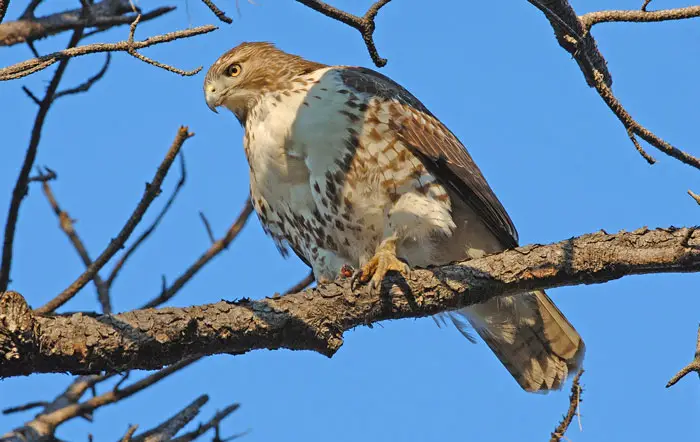
Intruders who venture into their territory may be met with swift and fierce attacks, as hawks will use their talons and wings to chase and attack perceived threats.
Similarly, Falcons are highly territorial during their nesting season. They’re known to dive and chase after anything that comes too close to them, regardless of the species or size of the intruder.
Differences in Nesting Habits and Breeding Behaviors
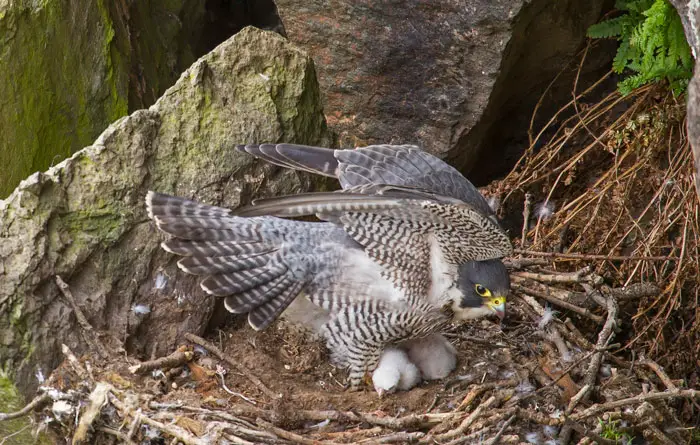
Nesting Habits
The female hawk lays eggs in the nest, and males and females take turns incubating the eggs. The incubation period can vary depending on the species of hawk, but it generally ranges from 28-35 days.
Falcons lay 3 to 4 eggs per clutch, with the female falcon being the primary incubator. The incubation duration for falcons varies depending on the species, but it typically ranges from 29 to 32 days.
During the incubation period, the female falcon and hawk may exhibit certain pregnancy habits such as increased territorial behavior, being more protective of the nest, and being more reliant on the male for food.
Breeding Behavior
Both are known to form monogamous pairs that mate for life. Hawks generally breed during the spring. However, in southern regions, hawks may breed earlier in the spring, while in northern regions, breeding may occur later in the spring.
Falcons breed in late March. Various factors influence breeding times, including climate, food availability, and mating behaviors.
Habitat Preferences
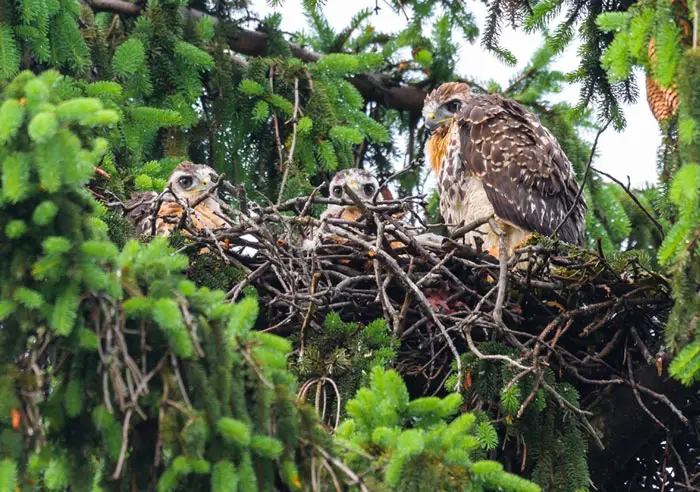
Habitat preferences of hawks and falcons are entirely different. Hawks are known to prefer a variety of habitats, including younger forests, deserts, and wetlands. They rarely build their nest in beech trees and pine plantations.
A falcon’s nest is called an eyrie. They usually choose an earthen cliff-ledge and grassy location. However, there is a growing trend of falcons using man-made structures such as buildings for nesting purposes.
Comparison of the Typical Altitude and Flight Patterns of Hawks and Falcons in their Respective Habitats.
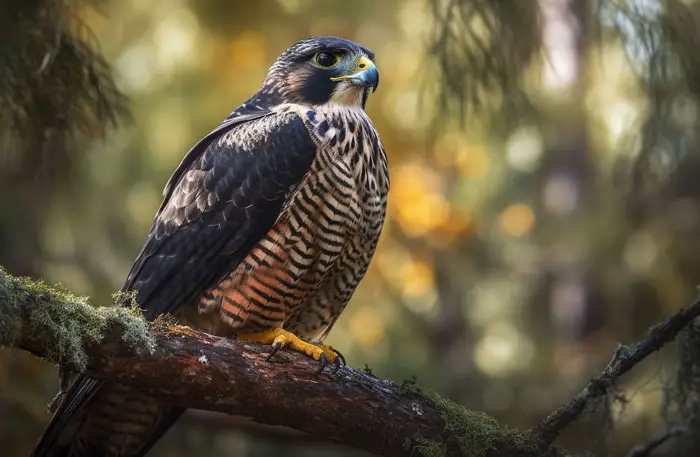
Altitude
A hawk can fly higher than a falcon. They can typically fly at high altitudes ranging from 10,000 to 15,000 feet. While falcon can only fly at an altitude of 3500 ft.
Flight Patterns
Hawks typically have a slower, gliding flight pattern than Falcons. They often soar in circles or hover while scanning the ground for prey. Falcons are known for their fast and agile flight, with rapid wing beats and sharp turns.
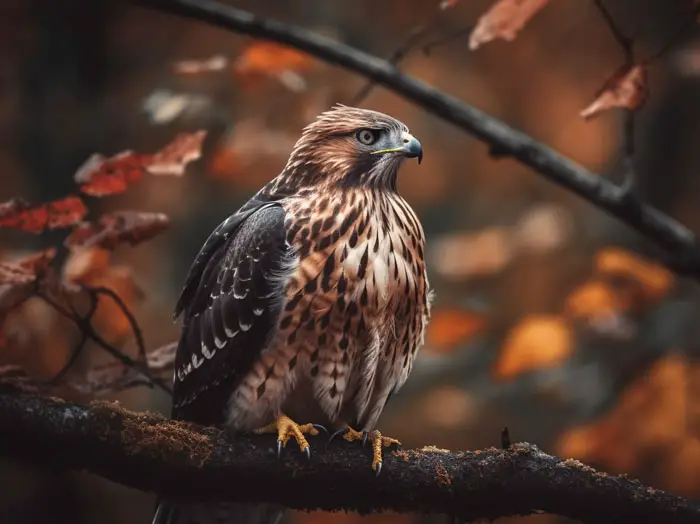
They can achieve remarkable speeds during their hunting dives, known as “stoops,” which can exceed 390 km/h in some species (Peregrine falcon).
Identifying Hawks and Falcons
Here is an overview of key characteristics for identifying hawks and falcons:
| Identifying Features | Hawks | Falcons |
|---|---|---|
| Size | Large | Small |
| Vocalizations | Calls and screams | Creaking and wailing |
| Tail Shape | Square-tipped | Round |
| Eye Shape | More spherical | More circular |
| Eye Placement | Forward-facing | Slightly more to the side |
| Hunting techniques | Hover | Stoop |
Different Species Falcons and Hawks and Their Identifying Features
Hawk
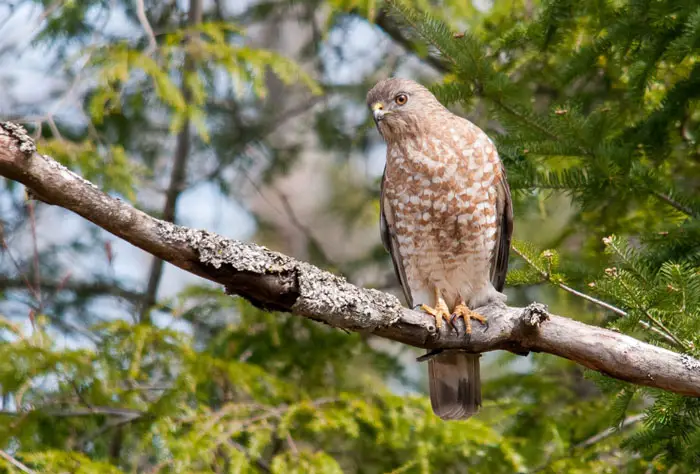
- Red-tailed: A large hawk with a broad, rounded tail that is often rich-brown in color. They’ve got a streaked belly band and a dark bar between the wrist and shoulder.
- Cooper’s: A medium-sized hawk with a slender body and short wings. They have a dark blue-gray on the underparts with a dark banded tail.
Falcon
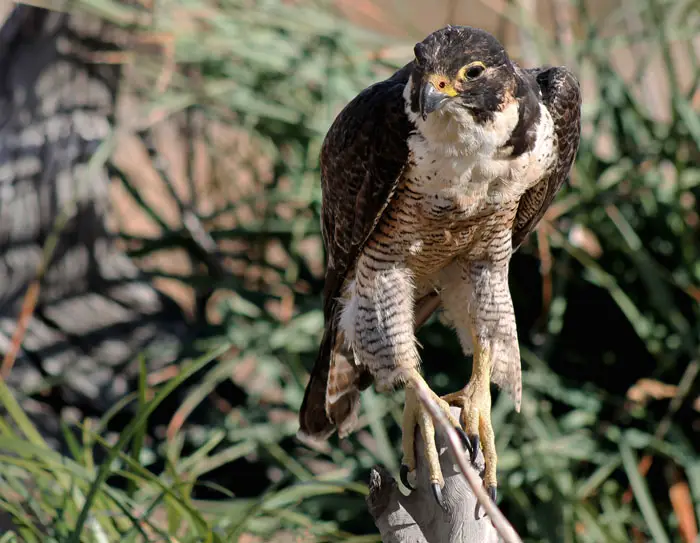
- Peregrine: A medium-sized falcon with a dark back and crown and a pale breast with dark bars.
- American Kestrel: A small falcon with colorful plumage with a rusty brown and black tail.
Tips for Differentiating Between Similar Species
Differentiating between similar species can be challenging. Still, several tips can help:
Call
Different species of falcon and hawks have distinctive calls, which can be used to identify them. Gyrfalcon’s call is harsh, while Common Kestrels is loud and excited.
Size
Pay attention to the size of the hawk. They vary in size. For example, a Red-tailed hawk is larger than a Broad-winged hawk, while Gyrfalcon is larger than Common kestrel.
Wings Shape
Different falcon species have characteristic body shapes and wing patterns. For example, Gyrfalcons have pointed wings, while Common kestrels have sickle-shaped wings.
Conservation and Protection
Both birds play critical ecological roles. Conservation and protection efforts are crucial to ensure their survival and well-being in the wild.
Many organizations worldwide are dedicated to the conservation of hawks and falcons, working towards their protection and promoting awareness about their importance.
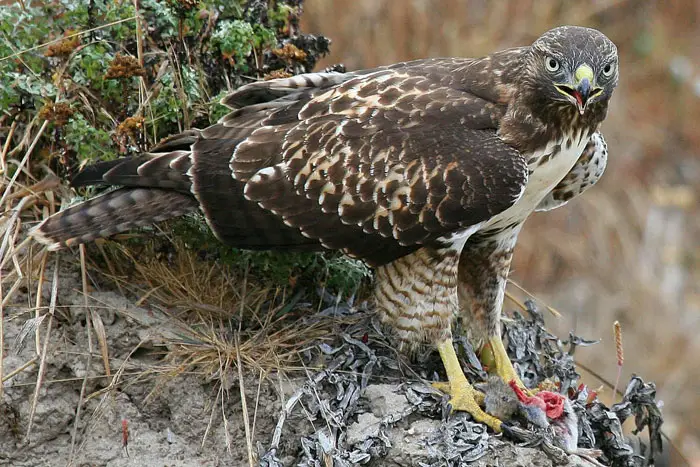
These organizations engage in activities such as habitat restoration, advocacy for policies and regulations that protect raptors, creating more birding hotspots, scientific research, public education, bird photography contests, and rehabilitation and release of injured or orphaned birds.
Here are some key aspects of conservation and protection efforts for hawks and falcons:
Habitat Conservation
Protecting and conserving natural habitats is essential for survival. This includes preserving forests, grasslands, wetlands, and other natural habitats that provide food, nesting sites, and suitable hunting grounds for these birds.
Anti-Poaching Measures
Poaching, or illegal hunting, threatens them significantly. Conservation efforts must involve strict enforcement of laws and regulations to prevent poaching and illegal trade of these birds and their eggs.
Captive Breeding and Reintroduction Programs
Some species of hawks (Ferruginous hawk) and falcons (Saker falcon) are endangered or threatened, and captive breeding programs can help in these bird conservation.
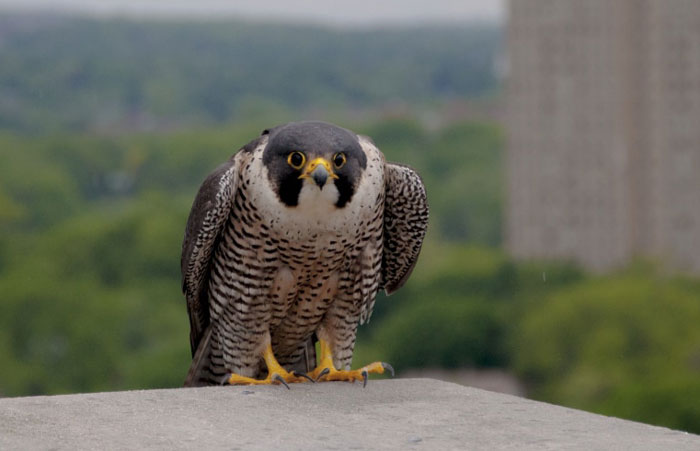
These programs involve breeding in captivity and reintroducing them into their natural habitats to boost their populations.
Education and Outreach
Creating awareness and educating local communities, stakeholders, and the general public about the importance of these birds in ecosystems and their conservation needs is crucial.
Research and Monitoring
Continuous ornithology research and monitoring are essential for understanding the behavior, ecology, and threats hawks and falcons face. This information helps in developing effective conservation strategies and management plans.
Collaboration and Partnerships
Conservation efforts require collaboration among various stakeholders, including government agencies, conservation organizations, local communities, researchers, and other relevant parties.
Conclusion
While hawks and falcons share many similarities in appearance and behavior, the two also have distinct differences. To sum up, hawks vs falcons, Hawks tend to be larger and more powerful, while falcons are known for their speed and agility.
Understanding the differences between hawks and falcons is important for birding, nature enthusiasts, conservation efforts, and ecological balance. Further research and bird watching opportunities can contribute to our knowledge and appreciation of these magnificent birds of prey.
So, grab your binoculars and head out to the field to witness the appalling beauty and behavior of hawks and falcons in the wild.
